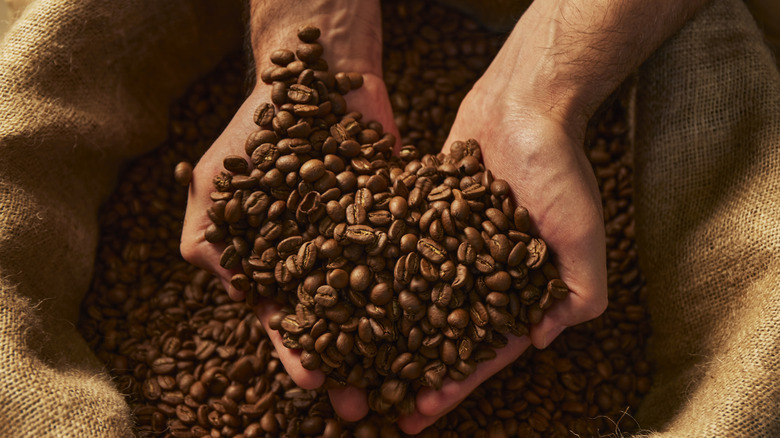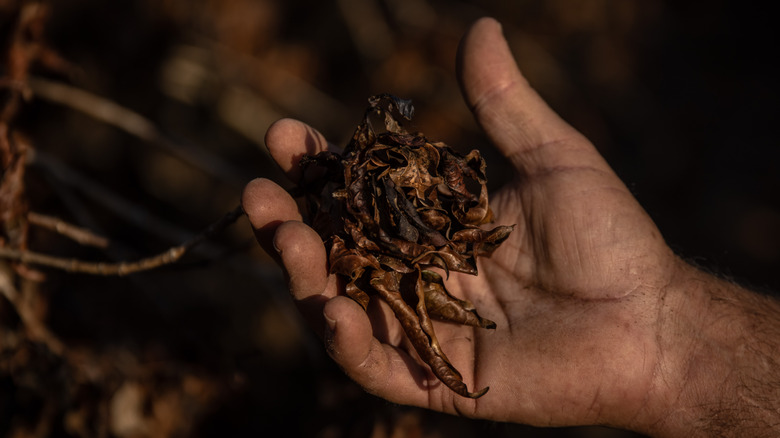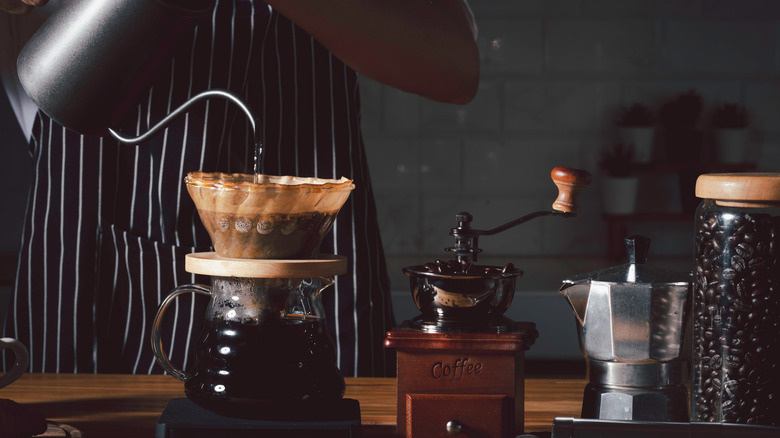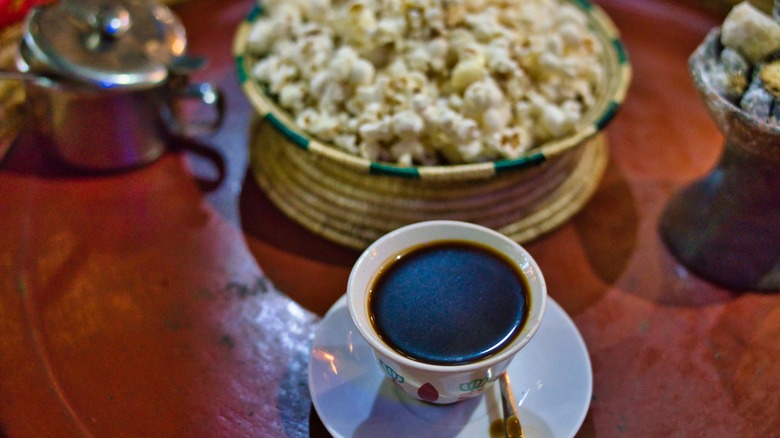The Ancient History Of Coffee
Coffee is so much more than a delicious beverage we rely on to jolt us awake in the morning ... and the afternoon and at night. From cold brew to flat whites to cà phê sữa đá, there are so many different types of coffee. And it is no surprise humans have come up with so many ways to consume this beverage. According to Healthline, coffee contains caffeine, which is a stimulant and the world's most commonly used drug — although medical authorities don't generally classify addiction to coffee as harmful enough to be a substance abuse disorder. However, that headache you get when you miss your morning cup is a withdrawal symptom. Moreover, many of coffee's addictive qualities are considered social rather than merely physical.
Coffee has a rich and frothy story, steeped in legend, that goes back to nearly ancient times. Since their discovery, these beans have been an important part of history, for better or worse. We will get into that, but first, a note on names. The names around coffee are a little misleading. Coffee "beans" are actually seeds from a berry, which is often called a cherry, of a plant in the Coffea genus. And there are about 103 species of coffee (per the Botanical Journal of the Linnean Society). Today, worth $100 billion globally, coffee is one of the most traded food commodities in the world. But how exactly did it get there?
Origin stories
The exact origin of coffee is unknown, but according to the National Coffee Association, it was first cultivated in Ethiopia. The most common legend is that a goat herder named Kaldi "discovered" it after his goats got hyped up after eating some coffee berries. They got so lively that they wouldn't go to bed. After that, Kaldi told an abbot at a monastery about what he had discovered. The abbot brewed the coffee, which kept him up all night during his prayers. From there, the good word about the beans spread.
While we do not have proof that this is how the story happened, Espresso International says Kaldi was said to have lived in either the sixth or ninth century. Antoine Faustus Nairon, a Roman professor, first recorded Kaldi's story in his 1671 book, "De Saluberrima potione Cahue seu Cafe nuncupata Discurscus." Whether the story is true or not does not really matter, as the legend is enduring. In fact, one of Ethiopia's most popular coffee chains is called Kaldi.
Nescafe mentions that coffee most likely originated with the nomadic Oroma and Galla tribes of East Africa. The Coffee Blog shares another possible discoverer: Moroccan Islamic scholar and Sufi, Sheik al-Shadhili. His story dates back to a manuscript published by Abd-al-Kâdir in 1587. The legend behind al-Shadhili's story is that sometime in the 12th or 13th century, he traveled near Ethiopia, where he noticed some very energetic birds. They had been eating, you guessed it, coffee berries.
From Ethiopia to Yemen
Like coffee's origins, this potent seed's journey from East Africa to the Middle East is filled with lore and conflicting accounts. Nonetheless, whether Sufi mystics discovered coffee or not, they certainly played a significant role in the drink's early history. According to Nescafe, legends of a bird-watching Yemeni Sufi scholar learning coffee's stimulating effects exist alongside those of Kaldi and al-Shadhili. However, most people agree that coffee originated in Ethiopia but was first cultivated in Yemen.
According to Al Aqeeq, Sufi monasteries were the first to process coffee over 500 years ago. And for about 200 years, Yemenis were the only people to grow coffee. Yemen's high-altitude, dry climate was not conducive to growing many other plants, but coffee thrives there. At first, people transported coffee beans via camel. Eventually, they began exporting it from the country's Mokha port on its Red Sea coast. Yes, that is where the word "mocha" originates.
Coffee was prevalent among Muslim mystics as the caffeine helped them stay awake to pray all night long. The drink became known as "Arab wine" as it became more and more known when pilgrims traveled to Mecca. In fact, one of the possible origins of the word coffee is connected to the Arabic word for wine (via Online Etymology Dictionary). Another possible etymology of the word coffee comes from the Kaffa region of Ethiopia, where coffee originated.
From Yemen to Southeast Asia
Coffee is a plant and a beverage that has traveled far and wide, and now it is available practically everywhere. One of the places where it has been a long time is India, but how did it get there? According to We The Origin, Baba Budan, a pilgrim to Mecca, smuggled six coffee beans from the Mocha port in Yemen back to India in the early 17th century. He planted them in Chikamagalur, Karnataka, and by the 1800s, coffee was an important export crop in India.
The Philippine Coffee Board shares its own country's complex history with the bean. One popular legend is that a Franciscan monk brought about two kilos of Arabica coffee beans with him when he arrived in the country in the 1700s. There are also theories that coffee may have accompanied 19th-century Arab and Muslim traders and pilgrims along their trade routes. However it arrived, today, the Philippines produces four varieties of commercial-grade coffee: Arabica, Robusta, Liberica, and Excels. It's one of the few countries to do so.
The history of coffee in Indonesia also traces its roots to colonization and trade. Coffee became so vital to the Indonesia-Dutch connection that the nickname "java" comes from the Indonesian island. Per Indonesia Expat, the Dutch Colonial government first brought coffee to Java in 1696 after smuggling it out of Yemen. Later, the Dutch East India Company — while not directly involved in cultivation — imposed coffee crop production quotas.
The Middle Eastern coffee house
These days, we say "spill the tea," but in many parts of the world, "spill the coffee" would have been a more appropriate term. It's likely still applicable today. Before the 17th century, coffee was pretty much only found in the Middle East. By the 15th and 16th centuries, the region had a vibrant coffee culture (via Kopliwak Direct). People consumed coffee in their homes and public coffee houses. These coffee houses were places of social gathering, where people played games like chess and exchanged information. These coffee houses still thrive, particularly in Muslim-majority regions where most people don't consume alcohol.
It is true that coffee has become synonymous with hospitality throughout the world, but this is not to be taken lightly in the Middle East. For example, to this day, people in Turkey share Turkish coffee to seal a marriage engagement. In other countries, it would be rude not to share a cup of coffee with a house guest.
What is Turkish coffee? Turkish coffee might be called Egyptian or Syrian coffee, depending on where you are. Still, the primary method of preparation is the same. The coffee is ground very finely. Traditionally coffee is boiled on the stove in a specific pot and served in a small cup — grounds and all.
Coffee arrives in Europe
For many, thinking of coffee conjures up images of espresso, cortados, or lattes — all European drinks. So how did coffee get to Europe? Clue Sheet says the Dutch began importing coffee from Yemen in the 17th century. But by the 1700s, they began growing coffee in their colonies in Indonesia.
Taste of Austria details the legend of how coffee made a more permanent home in Europe. In 1683, the Polish-Habsbsurg army defeated the Ottoman army in its blockade of Vienna. The Polish-Habsburg army then discovered coffee beans among the items the Ottomans left behind. The first official Austrian coffee house opened two years later.
Meanwhile, coffee was also introduced to England in the 1600s. There, coffee helped form the country's modern democracy, says the BBC. In the mid-17th century, Pasqua Rosee opened a coffee stall in St. Michael's churchyard to entertain his boss' guests. Soon, his stall became a store. By the 1660s, London had 83 coffeehouses, which became popular locations for businessmen (yes, men) to gather. Men of all social classes exchanged political ideas, news, and gossip in a period of radical social change.
The Venetian Republic introduced coffee to Italy when they brought coffee back from the Middle East. Once the Catholic Church put its stamp of approval on the beverage, Venice opened Italy's first coffee shop in 1675. One hundred years later, the city was home to 218 coffee shops. Italian coffee culture has been thriving ever since.
Coffee's grim history in the Americas
Unfortunately, coffee's history in the Americas is inextricable from the slave trade and war. Coffee became popular in Europe in the 17th century, and to fuel their need for java, European colonialists used the enslaved people in their colonies (per History). In fact, Haiti (then a French colony) grew ⅔ of the world's coffee at one point. After the Haitian Revolution in 1791, the Portuguese quickly converted Brazil into the largest coffee producer in the world. They were able to do this because Brazil did not abolish slavery for another 100 years.
Coffee also had a role in Latin American civil wars. During the cold war, the United States government felt threatened by communist or socialist policies in neighboring countries. So, in 1954, when Guatemalan president Jacobo Árbenz Guzmán and the country's communist party began allocating coffee plantations to co-ops, the U.S. backed a coup to remove Guzmán. Similar stories repeated themselves in Nicaragua and El Salvador in subsequent decades, resulting in civil wars.
On a marginally less depressing note, the Boston Tea Party helped popularize coffee in the U.S. In 1773, the British parliament instituted the Tea Act purportedly to get out of debt. That act gave the British East India Tea Company total control over the tea trade and passed the taxes onto the colonies. U.S. Americans rebelled and decided that instead of paying taxes on their annual 1.2 million pounds of tea, maybe they'd just drink coffee instead.
Coffee ... and religion?
Since its discovery, coffee has rubbed elbows with religion, for better or worse. Per Alimentarium, Sufi Muslims have long enjoyed coffee's stimulating effects to keep them up for nighttime prayers. Coffee or Die says that Jews have long drunk black coffee, which is kosher when staying up to study the Torah. Wiccans and other Pagans, meanwhile, have long used coffee grounds for divination. Not all religious authorities agreed with these coffee devotees, though. According to History Extra, throughout the 16th century, many Muslim leaders in Mecca argued about whether coffee was intoxicating. Therefore, many thought it should be banned.
Because the drink originated in the Near East, some 16th-century Italian Catholics were suspicious of it. There were even attempts to ban it (via Mental Floss). However, after tasting it, Pope Clement VIII proclaimed, "This devil's drink is so delicious ... we should cheat the devil by baptizing it!" And he did then bless coffee.
Even today, there are religious movements that refrain from drinking coffee. According to Learn Religions, this includes followers of the LDS Church, Seventh-Day Adventists, and Rastafarians. Some believe caffeine consumption to be similar to alcohol or tobacco use, and others follow prohibitions laid out in their religious texts.
Other coffee inventions
Coffee itself is old enough to be considered ancient. However, many of the inventions we use to consume our modern cup(s) of joe are less so. Per Britannica, there are many ways to make coffee. Two typical methods, steeping and boiling, involve ground coffee and boiling-hot water meeting before the coffee is strained. A french press uses steeping and infusion since the coffee grounds stay in the apparatus, separated by a plunger. You don't need to use heat in the steeping method; in fact, that's the difference between cold brew and iced coffee. Iced coffee is cooled hot-brewed coffee, and cold brew is brewed cold.
Another method, percolation, sees the water boiled before dripping over the coffee, filtering through it, and repeating. Drip coffee is similar, but the water doesn't recirculate. As noted by Coffee.Org, many believe the first coffee to be made by this method was made in 1908, when Melitta Bentz of Germany used blotting paper to create a filter. Viola, the modern coffee maker, was born — in a manner of speaking.
Espresso and single-serve coffee machines use pressure to force water through coffee grounds. According to Local Histories, Italian Achille Gaggia invented the espresso machine in 1946. Instant coffee predates both these inventions; New Zealander David Strang came up with instant coffee in 1889. And decaf coffee came into being just four years later.
The waves of coffee culture
There are three major waves of its history that define coffee culture. Barista Trish Rothgeb coined the idea in 2002. The first wave began in the 1800s when the average household began to stock coffee in their pantries. Large-scale coffee producers (think Folgers, Maxwell House, and Nescafé) are responsible for this shift. Instant coffee and vacuum-seal bags also helped people bring coffee into their homes by making these items more affordable and longer-lasting.
The second wave of U.S. American coffee culture began in the 1960s with the popularization of coffee houses and cafes. The trend really took off with Starbucks in the 1990s. Customer service, "creative" espresso drinks, and specific coffee-house ambiance are indicators of this wave. This era is also when coffee culture truly made a mark on U.S. Americans. It hasn't really let up since.
That brings us to the third wave, the one we are currently still experiencing. This one began in the early aughts. It highlights the coffee's origin, production, and roasting method, which are often listed on menu boards or coffee packages.
Coffee then versus now
Today, there are so many ways that people drink coffee around the world. From Greek frappé to Cafe Cubano to Finnish cheese coffee, there really is no wrong way to enjoy this delicious brew. With the advent of nitro coffee, we even have coffee on tap these days. If you ever travel to Ethiopia, Eritrea, or a restaurant for their cuisines, expect to be served popcorn alongside your coffee (per Atlas Obscura). But you do not even need to drink your coffee. There are considerable ways to cook with coffee and eat this awesome seed. Coffee is excellent in desserts like tiramisu and java cake, but don't be afraid to try it as a steak rub or an add-in to elevate your stew. It's also a great secret ingredient in sauces like mole or barbecue.
But how did people first enjoy their coffee? Coffee Blog says people may have eaten coffee before ever drinking it. Allegedly, East African tribespeople mixed coffee berries and animal fat to make protein energy balls. Other legends state that people first drank coffee all the way back in Kaldi's time. According to The World Bank, when the fabled Ethiopian goat herder brought his newly discovered coffee beans to a monastery, the monks threw them in the fire because they thought they were "devilish." But then they smelled the delicious roasting beans and brewed them. So, like much of coffee's origin, the way people began drinking coffee remains a mystery.










